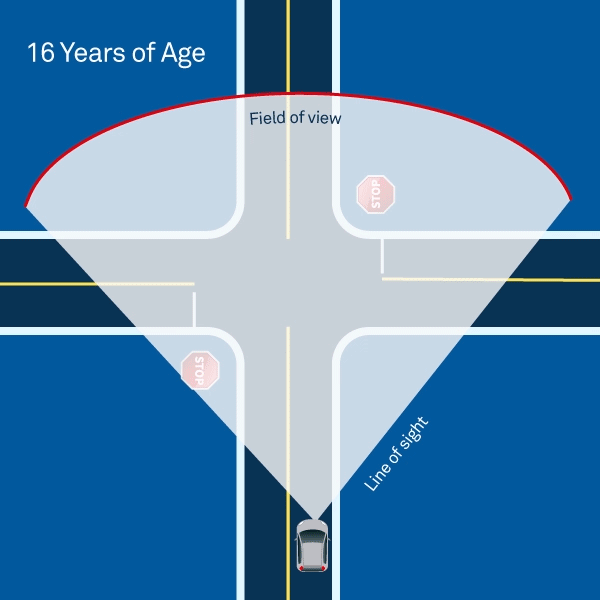Effects of aging on driving

Perception, decision-making, and reflexes behind the wheel
You have to make more than 10 decisions for every kilometre you drive, and have less than half a second to react to avoid an accident. That means you need to be in peak physical and mental condition in order to drive, at any age. Age takes a different toll on all of us, but in general you can expect your sensory (hearing and sight), cognitive (memory and attention), and physical (coordination and strength) abilities to be impacted.
Sight: Your strongest sense as a driver
When driving, we use our vision more than any other sense. Our eyes take in up to 85% of the information we need to make good decisions behind the wheel. Yet our eyesight begins to deteriorate after age 40. How much worse will it get? See for yourself:
The amount of light needed to drive roughly doubles every 13 years.
A 45-year-old requires four times as much light as a 19-year-old, and someone in their 60s needs 10 times as much.

Age 20
Young adults need little light to see well when driving at night.

Age 40
With age, our pupils shrink and are less responsive to changes in ambient light.

Age 60
60-year-old drivers need three times as much light to see in the dark than they did when they were teens, and twice as much time to adjust from light to darkness.

Age 80
During the day, an 80-year-old driver perceives six times less light than a 20-year-old does. And at night they perceive 16 times less!
The ability to focus clearly also declines with age.
Drivers over 40 take three seconds or longer to adjust their focus from near to far (such as when looking down at the speedometer and back up at the road), and this time increases with age.
Older drivers are more sensitive to glare.
The structure of our eyes changes with age: The lenses thicken, pupils shrink, and muscles lose their elasticity. A 55-year-old takes eight times longer to recover from glare than a 16-year-old.
This delay affects the ability to drive at night, through tunnels, and even on shady streets. Older drivers can also be blinded by the higher headlights of large vehicles (pickup trucks, vans, and SUVs).
Video available in French only
Sensitivity to contrast declines with age.
This makes it harder to make out a grey car or a pedestrian wearing beige.
Peripheral vision deteriorates with age.
Depth perception also gets worse, making it harder to judge how fast other cars are moving. This can:
Increase the risk of side-impact collisions at intersections
Make it difficult to pick things out, especially if they blend into a visually busy environment
Make certain colours, like red, seem less bright

People of a certain age are also more likely to develop vision impairments like glaucoma and cataracts.
Night driving
Night driving can be a challenge for any driver, but especially for older people who need more light and concentration. Here are a few tips for driving safely at night:
Obey the speed limit.
Stick to familiar routes.
Increase the distance between you and the vehicle in from of you to at least four car lengths.
Medications and driving
It’s a fact: Older drivers take more medications than younger ones. Many prescription and over-the-counter medications (cold and allergy medicine, cough syrup, and various sleep aids) cause drowsiness or fatigue, and some can even prolong reaction time and impair driving.
Medications pose real risks
Although statistics linking prescription drug use to collision rates are hard to come by, multiple studies have shown that medications commonly prescribed to relieve anxiety, stress, and muscle spasms can double the risk of a collision.
Alcohol, drugs, and prescription medications: A dangerous mix!
Mixing multiple medications with alcohol can cause unexpected and dangerous side effects and further impair driving ability.
Even consuming alcohol alone poses a huge risk. Research shows that as people age, their tolerance to alcohol goes down but the effects last longer.
Drug use, whether for recreational or therapeutic purposes, is just as dangerous as drinking and driving. Driving high is driving impaired.
Do you need personalized advice for your vehicle?
Our Mobility Advisory Services specialists can answer your questions about vehicles of all kinds. Feel free to ask for their input, maintenance advice or a list price. It’s just one of the benefits of membership, and there’s no limit to the number of calls you can make.
